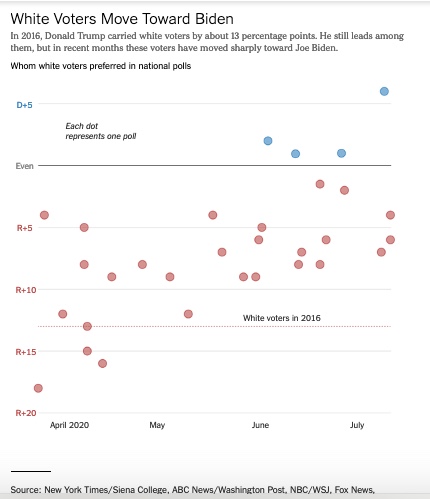Recent national polls show that Joe Biden’s commanding lead has eroded longstanding demographic divisions that have favored Republicans, endangering their hold on a tier of states where the Democratic Party usually has little chance to prevail in federal elections, even Republican strongholds like Kansas or Alaska.Live UpdatesFollow our live coverage of the 2020 election.
President Trump still has plenty of time to close the gap with Mr. Biden. But with Mr. Biden’s lead enduring well into a second month amid a worsening coronavirus pandemic, it’s worth considering the potential consequences of a decisive Biden victory.
Remarkably, Mr. Trump’s lead among white voters has all but vanished. On average, he holds just a three-point lead among them, 48 percent to 45 percent, across an average of high-quality telephone surveys since June 1. His lead among white voters has steadily diminished since April.
But if the president does not claw his way back into a tighter race, Mr. Trump and his party face a harsh political environment without many of the advantages that have insulated the party from public opinion in the past. Over the last two decades, Republican strength among white voters has given the party structural advantages in the House, the Senate and the Electoral College. A competitive race among white voters would deprive Republicans of those advantages, threatening carefully devised gerrymanders and raising the specter of previously unimagined losses in the Senate.
After 20 years of closely fought presidential elections, it’s hard to imagine the range of possibilities such a decisive margin of victory would create. To illustrate, we took the results of the 2016 election by demographic group and calculated what would happen if those groups backed Mr. Trump at the levels shown in recent polls.




